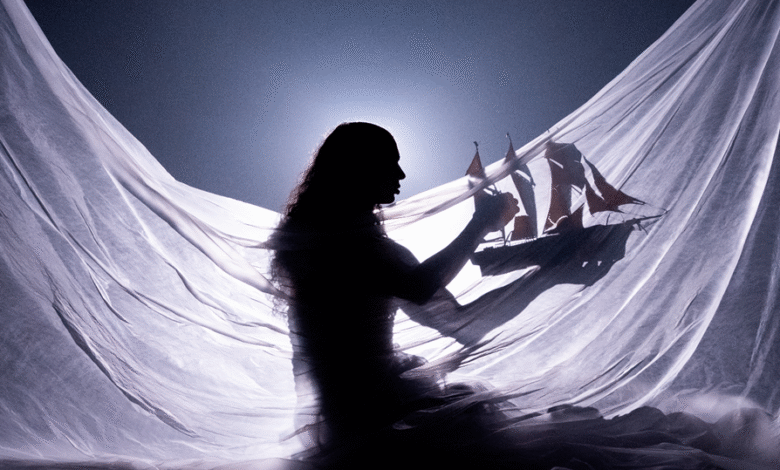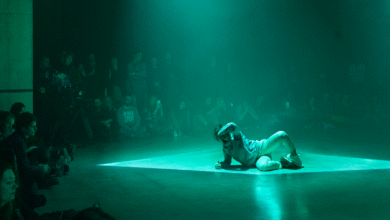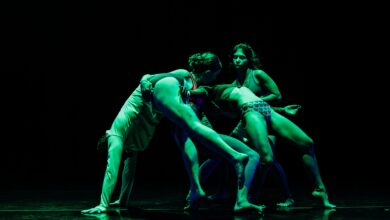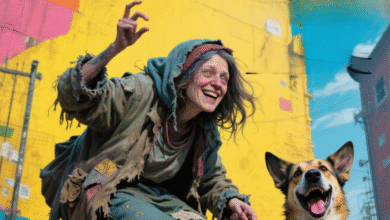Review: Little M, The Place
A coming of age story reimagined using dance, projection and puppetry to transform The Little Mermaid into an aesthetic tale/tail of acceptance and self-discovery.Rating
Good
The basement cafe at The Place has a dance student vibe, and it was good to be reminded that it is an innovative, working building and home to London Contemporary Dance School; particularly when Little M, a reimagining of Hans Christian Andersen’s The Little Mermaid is choreographed and co- directed by Anders Duckworth, a former LCDS graduate and currently a Work Place five year collaborative artist.
Little M is written by Luke Skilbeck (who also co-directs) and mostly follows the original plot line and author’s intent using dance, puppetry and shadow projections. The collaboration between a talented trans/non-binary cast of four dancers and multi-disciplined creatives is purposeful, promising an inclusive 60 minute celebration of difference for audiences aged 8 and up.
Moody, dim neon pinks purples and greens light a rope-curtained set as four dancers (Jose Funnell, Áine Reynolds, Naissa Bjørn, Tylee Jones) create an atmospheric watery world with powered and continuous fluidity. This beneath world feels magical, aided by composer NikNak’s perfectly integrated soundtrack. Effective slow-flowing object manipulation includes the suitcase of treasures that prompts Little M’s journey to discover the land, and Scamp’s puppetry design is vivid and well-crafted, with graceful moving jellyfish and other agile fluorescent fish creating an animated landscape. With much potential for connection and allyship between Little M and Punk the paper lantern Pufferfish, they lack contrasting energy or deeper manipulation to realise their full potential!
The curious world above misses the same visual wonder and the piece seems unbalanced because of this. The use of voiceovers doesn’t serve the characters either, and creates disconnection. The script- read dialogue lacks light or shade, which seems to diminish the fine physical storytelling rather than elevating the narrative. Little M embraces the dark of original fairy tales with brandished knives, walks like splintered glass, and tongues cut out – all brutal painful sacrifices, or bargains made – where an occasional beat of narrated exposition might be more useful than disconnected voices.
There is a recognisable, strong costume design by E. M. Parry, using a queer chic aesthetic to joyfully model dance fashion pieces, such as the folded swathes of material that suggest a merperson’s lower half rather than a literal fluke tail, along with nautically-garbed sailors, soft fabric dancing dresses and a ship headdress. Additionally, utilising floaty polythene enables a nice play on tides, horizons and shores, with a darker costumed version for the three handed oil slick of a Sea Witch. Again, not all the design serves the narrative clearly: some of the multi character motif pieces give a historical cultural mashup in places and are occasionally confusing.
Little M’s transformation from tail to legs is glorious as the choreography, costume and visual influences have a synergy with all the dancers. The iconic crab is fun too and the young audience enjoyed a release of laughter. The decision to make this a positive happy ending for Little M feels important for them, reinforcing values of kindness, acceptance and joyful celebration with their family and friends and making the messaging both specific and inclusive.
At its premiere, Little M feels like it is still in development: full of loving detail, currently the production sometimes swims against its tide of purpose. The technical and narrative imbalances are easily rectified so there is space to go further and make this an adult fairy tale, or lean into a younger audience and focus on how the form will best serve them with the production’s excellent intent. Little M offers an alternative world to bright synthetic animated versions of the original fairy tale, and from murkier depths there are definitely more starfish in the slipstream.
Choreography and Co-Directed by Anders Duckworth
Written and Co-Directed by Luke Skilbeck
Design by E. M. Parry
Composed by NikNak
Puppet Maker and Co-Design by Scamp
Co-Produced and commissioned by The Place. Supported by FEAST, Yorkshire Dance and Gendered Intelligence.
This production has finished its run at The Place







